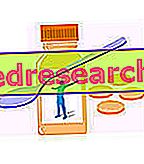See also: dandelion nutritional properties
Generality
Taxonomy and etymology of the dandelion
The dandelion ( Taraxacum officinale, Composite fam. Or Asteraceae) is a herbaceous plant particularly widespread in grassy and aerated areas of the whole Italian and world territory (it grows in meadows, on roads, on the banks of water courses and in other areas characterized by from damp soils; in gardening, dandelion is even considered a weed).

Some authors trace the origins of the name "dandelion" to the Greek terms "taraxis" (disorder, imbalance) and "akas" (remedy). It is therefore not surprising that dandelion is a well-known remedy in folk medicine.
The traditional denominations attributed to it in the various countries of the world are also significant, among which we recall the Italian " piscialetto " and the French "pissenlit". In the chapter dedicated to the properties and effectiveness of the dandelion, we will understand better why.
Description of the dandelion
The dandelion is easily recognized for its flower heads of intense yellow color, which close at sunset and reopen when light returns (the dandelion is also known as sunflower of the meadows ). The flower head is followed by a silver-white feathery globe, endowed with numerous achenes (seeds); hence the popular name of "soffione".
Indications
When to use dandelion?
The dandelion can be used for two purposes:
- As a vegetable food
- As a herbal remedy.
Dandelion food
The consumption of alimentary dandelions is indicated to increase the rations of soluble fibers , phytosterols, phenolic antioxidants, potassium, magnesium, vitamin C and carotenoids.
Dandelion - herbal remedy
The dandelion or the products obtained from it are useful for those who wish to increase diuresis and / or increase the synthesis of bile and bile flow, to purify / decongest / detoxify the liver .
Property and Effectiveness
Fitoelements of the dandelion
The dandelion contains a large number of pharmacologically active compounds; among these, they are of particular interest:
- Flavonoids, including: luteolin, apigenin, isocercitrina (a compound similar to quercetin), caffeic acid and chlorogenic acid.
- terpenoids
- triterpenes
- Sesquiterpenes.
What benefits has the dandelion shown?
The traditional empirical application of dandelion in humans, particularly for the treatment of digestive disorders, is supported by pharmacological investigations. However, some results, for example concerning diuretic activity, are even contradictory and require a thorough review.
As anticipated, the dandelion is commonly called piscialetto or pissenlit. These terms refer to the diuretic powers of dandelion leaves (rich in potassium and bitter substances), which can be used as a side food in the form of cooked vegetables, preferably "steamed".
Note : to cook the dandelion you can also use the method of boiling / drowning but it is good to remember that, when cooked, most active ingredients will be dispersed in the cooking water.
Beyond the universally known diuretic properties, the dandelion - in particular the rhizome and the root - increases the production of bile and its outflow from the liver to the intestine (properties respectively defined as cholagogues and choleretic). Its extracts are therefore used as purifying, decongestant and liver detoxifying.
The dandelion is also attributed anti-inflammatory, hypoglycemic, stimulating pancreatic and hypocholesterolemic activity (it promotes the elimination of bile excess cholesterol and reduces its absorption thanks to the richness of phytosterols and soluble fibers).
Like all composites, dandelion root is rich in inulin, a soluble fiber with prebiotic effects, useful for improving intestinal function and selecting a symbiotic enteric flora. Also noteworthy is the content of flavonoids, ascorbic acid, provitamin A and calcium.
The mild diuretic effects and the richness in potassium can help to regularize the body fluids and lower the arterial pressure (in this case the dandelion must necessarily be taken after consulting a doctor).
Main uses of the dandelionDandelion extracts are used, alone or in combination with other natural substances, in herbal products intended for the treatment and / or prevention of:
|
Doses and Mode of Use
How to use the dandelion?
The dandelion uses leaves and roots, which have more or less the same properties.
On the other hand, while the leaves can be used as food, the roots have an almost exclusively herbal or alternative purpose (for example, after roasting, drying and grinding, they can be used as a coffee substitute).
The flowers can be used for the formulation of the so-called " dendion wine ", that is an alcoholic drink with a dandelion flower, or for the jam or for a particular syrup (substitute for honey) with the addition of lemon.
The milky liquid that comes out when the root is cut has been used in the past as a mosquito repellent and as a folk remedy to treat warts.
Dried dandelion as a herbal remedy
The recommended daily dose of dry dandelion is 3-10 grams of drug (consisting of roots and aerial parts), to be taken three times a day. It is recommended to use it to produce a decoction, in order to maximize its diuretic effects. The decoction can be prepared by boiling and by boiling for 5 minutes in 100 ml of water, 5-7 grams of dried roots, leaving them to macerate for 5 minutes; filter before serving).
Watch the video
X Watch the video on youtubeFresh dandelion as a food
There is no recommendation on the portion of dandelion as a food. It is however advisable to respect a portion of about 100-200 g and a frequency of consumption such as to allow the alternation with the other vegetables.
Side effects
The dandelion is generally well tolerated; it can cause gastric acidity due to its content in bitter substances and allergic phenomena (due to the content in sesquiterpene lactones).
Contraindications
When should the dandelion not be used?
The intake of dandelion, especially in the form of a herbal remedy, is contraindicated:
- In the presence of gastritis, gastroesophageal reflux and peptic ulcer
- In the presence of calculosis or occlusion of the biliary tract (may possibly be undertaken under strict medical supervision)
- In the presence of renal failure
- During certain drug therapies (see below).
Pharmacological Interactions
Which drugs or foods can modify the effect of dandelion?
Given the high presence of potassium in dandelion roots and leaves, the concomitant intake of dietary mineral supplements can cause an excessive dietary intake of potassium. This association should therefore be avoided, especially in the case of impaired renal function.
Taking good kidney function for granted, hyperkalemia (excess potassium in the blood) is an almost impossible possibility, but excess potassium is still contraindicated.
Due to its ability to increase gastric acidity, dandelion can also increase the gastrolesive effects of NSAIDs (non-steroidal anti-inflammatory drugs, including aspirin and paracetamol).
Precautions for Use
What do you need to know before taking the dandelion?
Before using the dandelion, it is good to keep in mind what we have specified in the paragraphs on side effects, contraindications and drug interactions.
The consumption of fresh dandelion is mainly related to the collection of wild or cultivated plants. It can be found almost all year round, but the season in which it is most abundant is spring. It is good practice to collect the plants that are still small and soft, grown in non-polluted places and possibly even before flowering.



